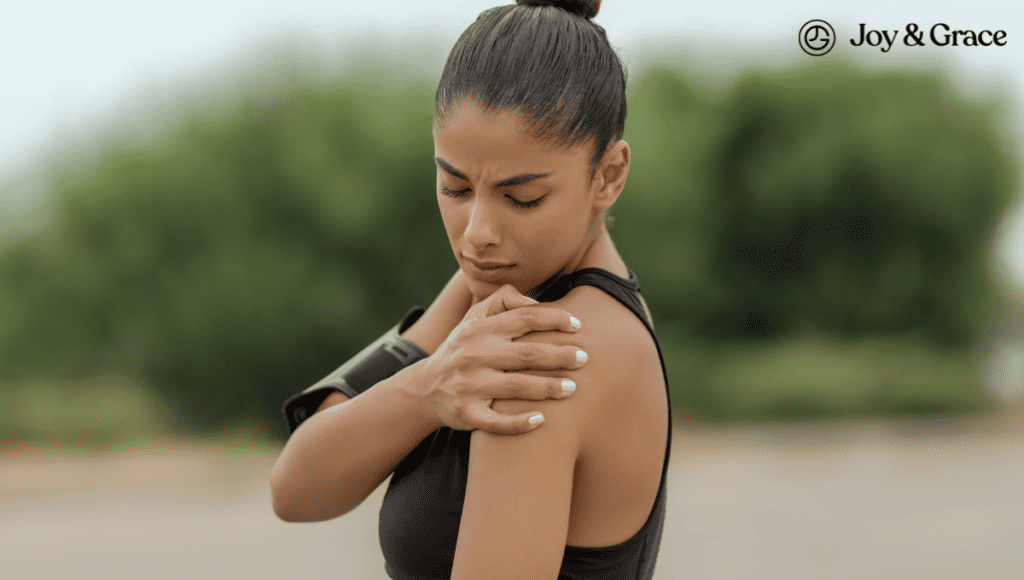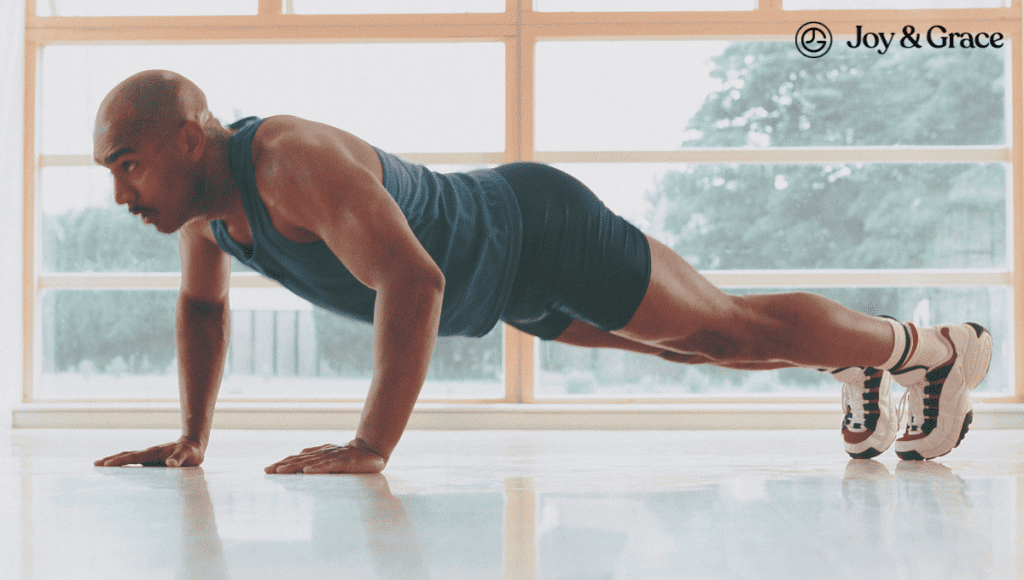Picture this: a pleasant stroll on a sunny afternoon, a chance to clear your mind and soak in the beauty around you. But suddenly, a twinge of discomfort in your shoulder threatens to steal away the joy and grace you seek from your walks.
But fear not! At Joy & Grace, we believe every step should be towards wellness and contentment. This blog will uncover the common reasons behind shoulder pain when walking. We’ll also equip you with simple yet effective strategies to overcome it.
Can Walking Cause Shoulder Pain?
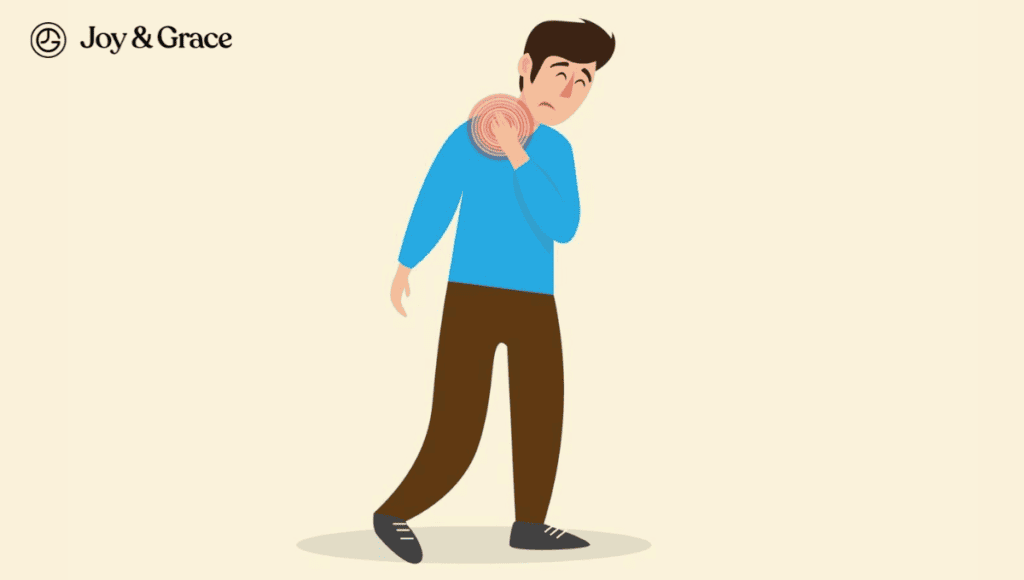
Yes, walking can sometimes cause shoulder pain.
Although it may seem like a low-impact activity, walking can sometimes lead to shoulder discomfort. But there’s a big “but” here. Walking usually only causes shoulder pain if you’re doing it wrong. It may sound surprising, but you might be unintentionally walking with improper form. As odd as it may seem, developing less-than-ideal walking habits is, in fact, a very common occurrence.
Another case where walking can cause shoulder pain is if there's a pre-existing condition present, whether directly or indirectly related to the shoulder.
But before diving into those, let’s look at how our bodies work when walking.
Walking involves a chain of movements that starts with your feet and goes up through your body. When you start walking, it all begins with lifting one foot off the ground and taking a step forward.
As your legs go through this motion, your hips and upper body get involved, too. They naturally twist a bit, like a gentle rotation, to counterbalance the movement of your legs. This twist helps you keep your balance and stay steady while walking.
Now, think about your arms as you walk. They're not just hanging there, right? They're swinging in sync with your legs. When your right leg steps forward, your left arm moves forward, and it works the other way around.
Meanwhile, your shoulders and neck keep your upper body in line. They work together to stop your head from bobbing up and down too much while you walk. Think of it as a way to maintain a smooth and comfortable stride. Imagine if your head bounced around like a tennis ball—it would be pretty uncomfortable, right?
What Causes Shoulder And Arm Pain When Walking?
As we mentioned earlier, the two most common causes of shoulder and arm pain when walking are poor walking habits and pre-existing shoulder conditions.
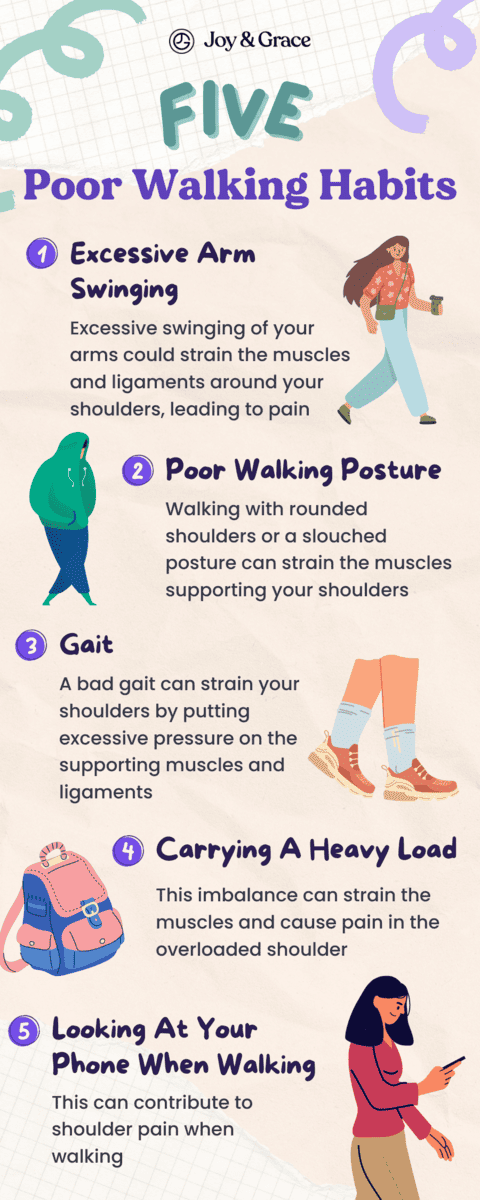
Poor Walking Habits
These are probably the most common causes of shoulder pain while walking. They include things such as:
Excessive Arm Swinging
When you swing your arms while walking, your shoulder muscles start getting more involved. Excessive swinging of your arms could strain the muscles and ligaments around your shoulders, leading to pain.
Likewise, keeping your arms too rigid and not allowing them to swing naturally can create tension in your arms and shoulders.
Poor Walking Posture
Maintaining good posture is crucial while walking. Walking with rounded shoulders or a slouched posture can strain the muscles supporting your shoulders. This can result in shoulder pain and discomfort in your upper back and neck.
Gait
Gait refers to the way we walk. Different people might have slightly different gaits. This depends on:
- Body structure
- Walking speed
- Injuries or medical conditions
A bad gait can strain your shoulders by putting excessive pressure on the supporting muscles and ligaments.
Carrying A Heavy Load
If you're carrying a heavy bag or backpack while walking, the weight can cause your shoulders to become uneven. This can lead to one shoulder bearing more weight than the other. This imbalance can strain the muscles and cause pain in the overloaded shoulder.
Looking At Your Phone When Walking
If you constantly look at your phone during your walks, you may end up straining your neck and muscles. This can contribute to shoulder pain when walking. We’ll touch more on this later.
Pre-existing Conditions

If not properly addressed, some conditions can cause shoulder pain even with low-impact activities like walking. The most common causes are:
- Shoulder Conditions
Various shoulder injuries and issues, like rotator cuff tendinitis or a rotator cuff tear, can lead to shoulder pain. Walking can exacerbate the pain from these conditions. We’ll discuss these and many more just a bit later.
- Uneven Leg Length
Another factor that can affect gait is leg length. Some people will have leg length discrepancies. Basically, one of your legs is shorter than the other. According to a study, people with leg length discrepancies have a higher risk of developing spinal issues.
While not mentioned in the study, these spinal changes could also affect the shoulder over time. This can contribute to shoulder pain when walking.
- Lower Extremity Weakness
Another possible factor is lower extremity weakness. A study examined the effect of weak legs on the shoulders in people who had polio before. The study concluded that lower extremity weakness can increase the risk of shoulder overuse.
Although it focuses on polio survivors, the study highlights that lower extremity weakness can lead to compensatory movements in the shoulders. People with weak lower extremities rely on their arms for support or balance during activities like walking. This may put extra strain on their shoulder muscles.
- Wear And Tear Due To Age
Our bodies naturally undergo wear and tear as we age, and our shoulders are no exception. This could make them more susceptible to pain, even during simple walking tasks.
Why Does My Right Shoulder Hurt When I Walk?

If you experience pain only in your right shoulder, it may be possible that an existing condition is present, whether directly or indirectly related to the shoulder. However, there’s no direct evidence that walking can trigger or worsen pain in the conditions we’ll mention.
In fact, walking is recommended if you have these conditions, as it’s a low-impact activity.
As long as you don’t flail your arms like a tube man when you walk, you’re good to go.
That said, here are some possible conditions to consider:
- Rotator Cuff Issues
The rotator cuff is a group of muscles and tendons that stabilize the shoulder joint. Problems with the rotator cuff can cause pain, especially during daily activities where arm movement is involved.
- Bursitis
Bursae are tiny, fluid-filled sacs that cushion and reduce friction between bones and tendons. Inflammation of the bursa in the shoulder (shoulder bursitis) can lead to pain during movement.
- Shoulder impingement
Shoulder impingement occurs when the shoulder blade puts pressure on the tissues underneath it. The pain is usually felt more while moving the shoulder, which includes the swinging motion often associated with walking.
- Frozen Shoulder
This is also known as adhesive capsulitis. A frozen shoulder can cause pain and stiffness in the shoulder joint, making movement painful.
- Heart Issues
In some cases, shoulder pain could be referred to as pain from heart-related issues, such as angina. This is less common but should be considered, especially if you have other heart-related risk factors.
However, it's important to note that there can be exceptions to this rule, particularly among individuals with neuropathies (conditions that cause nerve damage).
Neuropathies typically occur in the elderly and in diabetics.
The damaged nerves in this group of people make them unable to feel the typical signs of heart disease. As a result, heart issues may present atypically as sole shoulder pain when walking.
- Injury And Fractures
If you've had a recent fall or injury, it's possible that you've injured or fractured your shoulder, leading to pain during walking.
- Arthritis
Shoulder arthritis can cause pain, especially during movement. Osteoarthritis and rheumatoid arthritis are the two most common types affecting the shoulder joint.
- Other Medical Conditions
Certain medical conditions might cause referred pain in the shoulder area. Some organs share nerve connections with the shoulder, leading to shoulder pain when they are inflamed.
It’s important to note that these conditions can also cause pain in your left shoulder. They can even affect both shoulders. The pain from these conditions is often present even when you’re not walking.
Moreover, these conditions have symptoms other than shoulder pain. Having right shoulder pain alone doesn’t necessarily mean you have these conditions.
Why Do My Neck And Shoulders Hurt When I Walk?
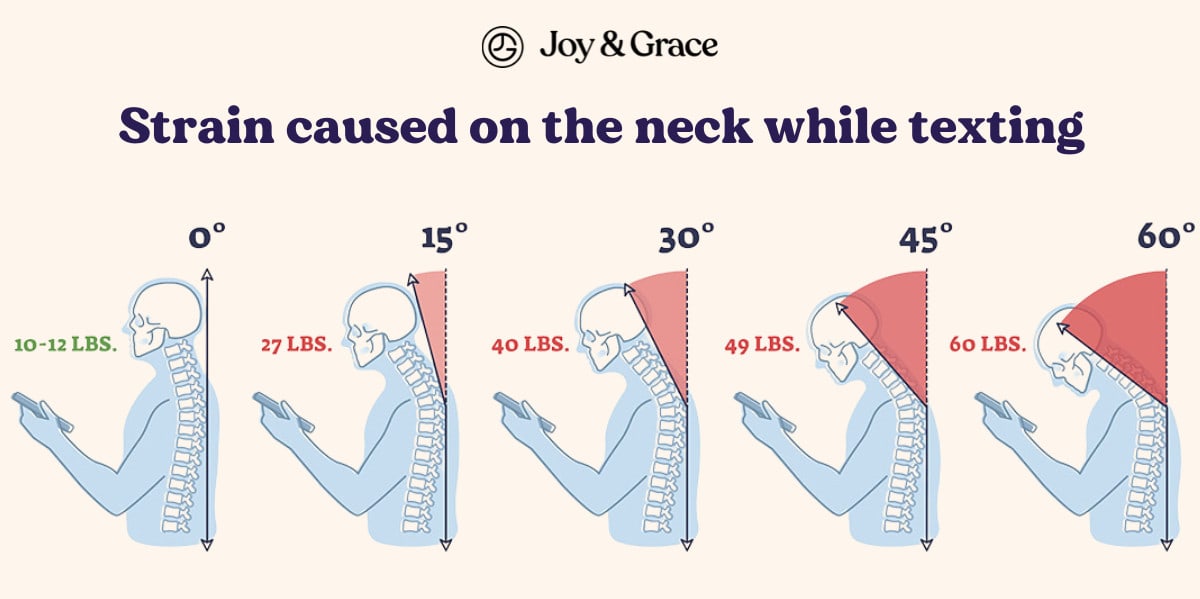
Some of the factors and conditions mentioned above could also cause neck pain when walking.
However, another possible cause is the tech neck. With the rise of technology, a lot of us find ourselves looking down at our screens most of the time. And yes, some of us do it even when walking.
Spending extended periods with your head tilted forward and your neck flexed can strain your neck muscles. Over time, this position can cause structural changes in your cervical spine.
Interestingly, the anticipation of stepping can also cause your neck to assume a forward head posture. Simply put, the moment you expect to take a step forward, your body may unconsciously thrust your neck and head forward.
Forward head posture refers to a posture in which your head is positioned forward instead of being aligned directly over your spine.
Both tech neck and forward head posture can lead to various issues, including cervical radiculopathy. This happens when a nerve in your neck is compressed or irritated. Cervical radiculopathy can cause pain in your neck that can radiate down to your shoulder.
What Can I Do To Prevent Neck And Shoulder Pain When Walking?
So, how can you prevent neck and shoulder pain and enjoy your walks again? Here are some tips.
- Maintain Proper Posture
- Keep your head aligned with your spine. Avoid leaning too far forward or looking down excessively.
- Keep your shoulders relaxed and down, not hunched or raised.
- Engage your core muscles to support your upper body and maintain stability.
- Choose the Right Footwear
Wear comfortable and supportive shoes that provide cushioning and proper arch support. This can help prevent improper gait that might lead to neck and shoulder strain.
- Supportive Gear
Consider wearing a brace or support to stabilize the shoulder and reduce muscle strain while walking. Also, consider wearing shoe lifts or insoles to help with any leg discrepancies causing improper gait.
- Warm-Up and Stretch
Perform gentle neck and shoulder stretches before walking to loosen up the muscles and improve circulation
- Maintain a Balanced Stride
Walk with a natural gait, taking smooth and controlled steps. Avoid overstriding or taking uneven steps.
- Use Proper Arm Movement
Let your arms swing naturally in sync with your stride. Avoid excessive swinging or tension in your arms.
- Stay Hydrated
Dehydration can lead to muscle stiffness and discomfort. Drink enough water before, during, and after your walk.
- Take Breaks
If you're walking for an extended period, take short breaks to stretch and relax your neck, shoulders, and back.
- Adjust Your Bag or Backpack
If you're carrying a bag or backpack, ensure it's light enough. Opt for a backpack with padded straps and distribute the weight evenly.
- Pay Attention to Ergonomics
If you're walking with a device like a smartphone, hold it at eye level to avoid looking down for extended periods. But it’s best to put the phone away to avoid any accidents.
- Strengthen Your Core and Upper Body
Perform exercises that strengthen your core, upper back, and shoulder muscles. These exercises can help provide better support for your spine and posture.
What Exercises Can Help With Shoulder Pain From Walking?
Certain exercises can help relieve shoulder pain from walking and prevent it from happening again. Here are some simple exercises that target your shoulders:
- Start by standing or sitting upright, then roll your shoulders slowly in a circular motion.
- Perform about ten clockwise rotations, then reverse the direction.
- Extend your arms out to the sides at shoulder height.
- Circle your arms forward for 30 seconds and backward for another 30 seconds.
- Stand in an open doorway.
- Reach your arms up to touch the door frame.
- Gently lean forward to stretch your shoulders and chest
- Grip a resistance band with both hands and pull it apart, keeping your elbows close to your body.
- Perform three sets of 10-15 reps
We have a more extensive list of neck and shoulder exercises here. Make sure to work both shoulders, not just the one that hurts. Over time, these simple exercises can help prevent shoulder pain when walking and enhance overall shoulder health.
Can Leg Exercises Help With Shoulder Pain From Walking?
While they may seem unrelated, certain leg exercises can indirectly help people with shoulder pain from walking.
As we mentioned earlier, your entire body is involved in walking. If you have imbalances or weakness in one part of your body, they can affect other areas, including your shoulders.
Strengthening your legs can improve your overall posture and body mechanics. This can help reduce stress on your shoulders when walking.
Here's how leg exercises can help with shoulder pain from walking:
- Core and Hip Stability
Leg exercises that engage your core and hip muscles can improve overall stability. A strong core and stable hips help maintain proper posture while walking. This can reduce the likelihood of slouching or leaning forward.
- Balanced Body Mechanics
Leg exercises like squats and lunges encourage proper alignment of your lower body. When your legs are strong and aligned, it can positively affect your upper body's alignment. This reduces the chances of compensatory movements that might contribute to shoulder pain.
- Gait Improvement
When your legs are strong and coordinated, your gait tends to be smoother and more balanced. A well-coordinated gait can help distribute forces evenly throughout your body. This helps prevent excessive stress on specific areas like your neck and shoulders.
Leg Strengthening Exercises To Help With Shoulder Pain From Walking
Here are some simple leg-strengthening exercises that you can start with:
- Bodyweight Squats
- Stand with your feet shoulder-width apart.
- Lower your body by bending your knees and hips as if sitting back in a chair.
- Keep your chest up, back straight, and weight on your heels.
- Lower until your thighs are parallel to the ground, or as far as you're comfortable.
- Push through your heels to return to the starting position.
- Aim for three sets of 10–15 reps.
- Lunges
- Start by standing with your feet together.
- Step forward with one leg and lower your body until both knees are bent at 90-degree angles.
- Your back knee should hover just above the ground.
- Push through the front heel to return to the starting position.
- Alternate legs for each repetition.
- Aim for three sets of 10–12 reps on each leg.
- Glute Bridges
- Lie on your back with your knees bent and feet flat on the floor, hip-width apart.
- Engage your core and glutes, then lift your hips off the ground until your body forms a straight line from your shoulders to your knees.
- Squeeze your glutes at the top and hold for a moment.
- Lower your hips back down.
- Aim for three sets of 12–15 reps.
- Step-Ups
- Find a stable step or platform.
- Step onto the platform with one foot, then bring the other foot up.
- Step back down in reverse order.
- Use your entire foot to step up and down, not just your toes.
- Aim for three sets of 10–12 reps on each leg.
- Calf Raises
- Stand with your feet hip-width apart.
- Raise your heels as high as you can while standing on the balls of your feet.
- Lower your heels back down.
- You can do this exercise with both feet at the same time or one foot at a time.
- Aim for three sets of 15–20 reps.
Remember to maintain proper form and start with a comfortable number of repetitions and sets. As you get stronger, you can gradually increase the intensity.
If you're new to exercising or have any underlying health concerns, it's a good idea to consult a healthcare professional before beginning a new exercise routine.
How Can I Relieve Shoulder Pain From Walking?
If you're experiencing shoulder pain from walking, there are several steps you can take to relieve the pain. Here’s how you can relieve your shoulder pain at home:
- Rest
Give your shoulders a break from any activities that exacerbate the pain.
- Ice
Applying an ice pack to the affected area for 15-20 minutes every few hours can help reduce inflammation.
- Heat
Applying heat, such as a warm towel or a heating pad, to your shoulders for 15-20 minutes can help relax tense muscles and increase blood flow.

- Massage and Self-Myofascial Release
Using a foam roller or a massage ball to target the muscles around your shoulders can help release tension and alleviate pain.
- Over-the-counter (OTC) Painkillers
Over-the-counter nonsteroidal anti-inflammatory drugs (NSAIDs) can help reduce pain and inflammation. Consult a doctor before taking any medication.
- Physical Therapy
A physical therapist can perform manual therapy to address the underlying cause of your shoulder pain. They can also build an exercise routine that’s tailored to your condition.
It's important to remember that while these may help relieve mild shoulder pain, only a medical professional can help with severe or persistent pain. They can accurately diagnose the underlying cause of your pain and provide you with a tailored treatment plan.
When Should I See A Doctor If I Have Shoulder Pain From Walking?

It's important to consider the nature of the pain and any accompanying symptoms to determine when you should see a doctor. Here are some guidelines:
Persistent or Severe Pain
If the shoulder pain is persistent, intense, or worsening, it's a good idea to consult a doctor. This could be indicative of an underlying issue that needs professional medical advice.
Accompanying Symptoms
If there are additional symptoms in addition to the shoulder pain, such as:
- Numbness
- Tingling
- Weakness in the arm
- Chest pain
- Shortness of breath
- Other unusual sensations
It could be a sign of a more serious condition. Seek medical attention immediately in such cases.
Reduced Range of Motion
If you notice a significant decrease in your shoulder's range of motion or it becomes difficult to move your arm, you should see a doctor.
Injury or Trauma
If you've recently experienced some type of injury or trauma to your shoulder or the surrounding area, consult a medical professional. Injuries might include strains, sprains, or fractures.
Chronic Pain
If you have a history of shoulder problems or a long-term condition like arthritis that makes walking painful, it is a good idea to talk to a doctor about it.
Swelling or Redness
Swelling, redness, or warmth around the shoulder joint could indicate inflammation or infection. This may require immediate medical attention.
Takeaway
Shoulder and neck pain during walking can be traced to several root causes. One common cause is the misuse or overuse of arm motion while walking. Poor posture while walking could also contribute to the discomfort. Problems with the lower half of your body can also contribute to shoulder pain.
In rare instances, shoulder pain when walking may be due to underlying issues with your shoulder. Understanding why your neck and shoulders hurt when you walk is the first step toward finding a solution.
Remember, you don’t have to suffer neck and shoulder pain when walking. There are many treatment options available, so you can continue enjoying your walks.
